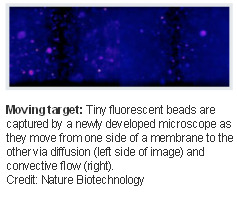Tags
Bethesda Maryland, DNA, European Molecular Biology Laboratory, Heidelberg, Jennifer Lippincott-Schwartz, Molecule, National Institutes of Health, Nature Biotechnology, Protein
Biomedicine
Watching the Protein Tango
A new technique helps researchers visualize molecules moving in close to real time.
Wednesday, August 17, 2011 By Lauren Gravitz Source – MDT Mag
 A new microscope has allowed researchers to watch molecules move within a cell on a millisecond-by-millisecond time scale for the first time. The novel method, which combines two preëxisting microscopic techniques, opens a window onto cellular processes that had previously been undetectable, unveiling molecular activity within a cell at a much finer level than ever before possible.
A new microscope has allowed researchers to watch molecules move within a cell on a millisecond-by-millisecond time scale for the first time. The novel method, which combines two preëxisting microscopic techniques, opens a window onto cellular processes that had previously been undetectable, unveiling molecular activity within a cell at a much finer level than ever before possible.
“This allows us to look at interactions of molecules, and their mobility,” says Malte Wachsmuth, a cell biophysicist at the European Molecular Biology Laboratory in Heidelberg, Germany, who helped develop the new microscope. Current microscopy techniques can home in on a single spot within a cell, but they can miss vital information when the focus moves from one spot to another. “A typical protein might spend one to two milliseconds in such a spot,” Wachsmuth says. “Molecules are quite mobile, diffusing all around, and it’s a very fast process. A lot can happen in a few tens of milliseconds.”
The technique developed by Wachsmuth and his colleagues allows them to analyze proteins and other molecules inside an entire cell, all at once, as they move about. It combines light-sheet microscopy, which illuminates just a thin plane of an object, and single-molecule spectroscopy, which can track movements of individual molecules. The result offers both high sensitivity and fast processing time.
The researchers believe the technology could be very helpful for understanding how proteins drive processes like transcription (the method through which DNA is expressed). “Understanding how proteins interact with each other is what everybody’s interested in, in terms of trying to decipher cell biochemistry,” says Jennifer Lippincott-Schwartz, a cell biologist at the National Institutes of Health in Bethesda, Maryland, who was not involved in the research.
The scientists quickly put their tool to use. “We could watch a single molecule in the nucleus of a cell as it goes from one compartment to another,” Wachsmuth says. He and his collaborators also examined how proteins bind to tightly wound DNA, called chromatin, during the process of transcription inside a cell’s nucleus. Researchers still don’t understand the intricacies of how transcription proceeds. Previous studies had suggested that when proteins are tagged with fluorescence, bright spots attached to the chromatin indicated longer binding times while dim spots indicated briefer visits. But when the researchers trained their new microscope on the process and analyzed protein movements within the nucleus, they found that the dynamics are far more complex, with binding times equal in dim areas and bright ones.
The results were published online this month by Nature Biotechnology. “This is only a first step to a better understanding of what’s really going on,” Wachsmuth says. He notes that his group is forging ahead on more detailed studies, including two-color imaging that will let them view interactions of different types of molecules.
“It’s an important paper, and a big step forward, but it leaves open a question: What does it all mean?” says John Sedat, a biophysicist at the University of California, San Francisco, who was not involved with the research. A complication of this work and other recent research in the same vein, he says, is that the technique requires a great deal of light. “To what extent are the photons you’re using disturbing the biology?” Sedat says. The protein movements documented in the paper might describe the cell’s true biology, or they might instead be an artifact caused by flooding the cell with too much light.
But it’s a good start. “It’s inside of a cell, which is important, because that’s where all the biology is,” Sedat says. “It’s not the highest magnification, not the highest resolution, but that’s not important to start with. All biology is occurring at these scales, and you can probably answer a huge number of biological questions if you have the spatial and time resolution these researchers and others getting.”
Related articles
- Watching the Protein Tango (technologyreview.in)
- Watching the Protein Tango (technologyreview.com)
- Live from the scene: Biochemistry in action (eurekalert.org)
- EMBL Scientists Develop Microscope to View Molecule Movement (azonano.com)
- Live from the scene: Biochemistry in action (physorg.com)
- Is this a new Natural-based Cancer Killer? New Study Shows Modified Citrus Pectin Activates Powerful Immune Responses (earlsview.com)
- Scripps Research scientists expand knowledge of cell process involved in many diseases (eurekalert.org)
- Australian Scientists Utilize Fluorescence Microscopy to Study T-cells (azonano.com)
- A closer look at cells (eurekalert.org)
- ‘Good’ prion-like proteins boost immune response (scienceblog.com)
- Kinetochores prefer the ‘silent’ DNA sections of the chromosome (sciencedaily.com)
- Epigenetics and Skeletal Diseases (brighthub.com)
- What is function of the following molecules in Eukaryote cell -Genomic DNA -mRNA -rRNA -tRNA -snRNA -microRNA (wiki.answers.com)
- EPFL Researchers Observe Cell Interaction using Fluorescence Microscopy (azonano.com)
